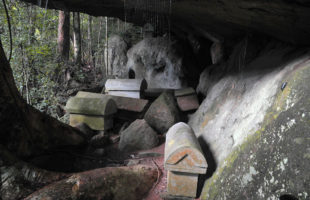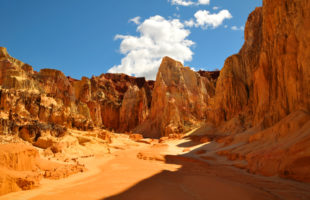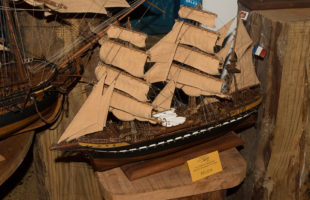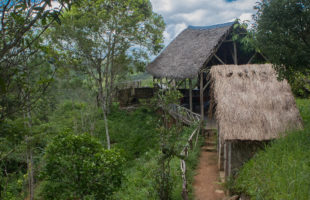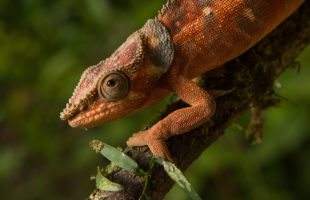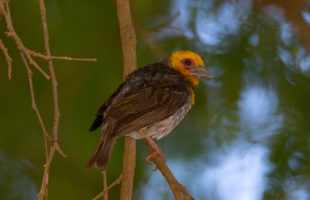If you visit the special reserve Nosy Mangabe in northeastern Madagascar, you will find some kind of graveyard halfway up to the highest point of the island. It is located in the west of the island, not far away from the campground and directly adjactent to one of the round trails. The graveyard belongs to the Betsimisaraka people who lives …
LesenMasika sipa
Spider with lasso: Deinopis madagascariensis
Madagascar is home to many strange creatures. A particularly obscure one is the Malagasy Net-casting Spider (Deinopis madagascariensis). As the name suggests, one characteristic of this spider is special: the way it catches its food. The Net-Casting Spider lets itself be suspended from a leaf or branch by a thread. Then it stretches a kind of lasso made of spinning …
LesenSecond world war – Operation Ironclad
Since the ceasefire of Compiègne in June 1940, wide parts of France, including the oversea territories and thus also the colony of Madagascar, were under German military administration with a French government in Vichy. This so-called Vichy government de facto owned Madagascar. Meanwhile, Japan had gained predominance in the Indian Ocean. The Germans planned to give Madagascar to the Japanese …
LesenAnkarafantsika national park
Ankarafantsika: The word itself means “spiny mountains” and alludes to the famous gorge of the park. Ankarafanstika is also called “the Kingdom of Birds“. Location: Ankarafantsika National Park is located in northwestern Madagascar in the Ambato Boeny region. It is located 420 km north of Antananarivo and 115 km west of the port city of Mahajanga. The RN4 connects both …
LesenModel ship workshop „Le Village“
Right in the middle of Antananarivo, in an inconspicious side street, there is an own small world: „Le village“ which means as much as „the village“. It is a row of workshops where they construct high-class true to scale ship models. For sure, you can find wood carving workers everywhere all over Madagascar – but ships of this outstanding quality …
LesenThe water tank of the South
Madagascar’s south put forth many quirky, mostly water saving plants. An especially strange and unique plant is Cyphostemma montagnacii. The shape of this plant seems to be not of this world: A small, gnarly stem merges into long vines. Indeed this strange plant belongs to the grapevine family. Its branches need a tree which they can climb up and which …
LesenVohimana reserve
Vohimana: Vohimana in the hilly highlands of eastern Madagascar is a small reserve that may be a little adventurous to reach by foot. Location: Vohimana is located about 155 km east of capital Antananarivo, in Alaotra-Mangoro region. Thus it is only 25 km far from much visited national park Andasibe-Mantadia. You can easily do day trips from there to Vohimana. …
LesenProtected area Maromizaha
Maromizaha: Actually this protected area consists of two forest areas, Maromizaha and Vohidrazana. The latter means as much as “mountain of the ancestors”. In contrast, the Malagasy words maro and mizaha can have two different meanings. It may be “the place where many people do research” but also “the forest which is exploited by many people”. Location: Maromizaha is located …
LesenThe Emerald Sea
The Emerald Sea (French mer d’emeraude) is a paradisiac lagoon at the entry of Antsiranana (Diego Suarez) bay at the northernmost tip of Madagascar. The name traces back to the turquoise, crystal clear, shallow water of the lagoon. The lagoon has a length of approximately 12 kilometres and is only three kilometres broad. A large coral reef and several islands …
LesenStrong together: The Sakalava weaver
The small, only 25 g weighing Sakalava weaver (Ploceus sakalava) only occur in Madagascar. As the name indicates, they belong to the weaver birds and are widely distributed around the island: Everywhere where the eponymous tribe of the Sakalava lives. This is mainly western Madagascar; from the deep, hot and dry South to the North. Sakalava weaver prefer dry areas. …
Lesen MADAMAGAZINE Your Magazine about Madagascar
MADAMAGAZINE Your Magazine about Madagascar
